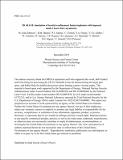3D xRAGE simulation of inertial confinement fusion implosion with imposed mode 2 laser drive asymmetry
Author(s)
Gatu Johnson, Maria; Haines, B.M.; Adrian, Patrick J.; Forrest, C.; Frenje, Johan A.; Glebov, V.Yu.; Grimble, W.; Janezic, R.; Knauer, J.P.; Lahmann, Brandon; Marshall, F.J.; Michel, T.; Séguin, Frederick H.; Stoeckl, C.; Petrasso, Richard D.; ... Show more Show less
Download19ja033_full.pdf (2.243Mb)
Metadata
Show full item recordAbstract
Low-mode asymmetries represent an important obstacle to achieving high-gain inertial confinement fusion implosions. As a step in learning how to control such effects, an OMEGA experiment with imposed mode 2 laser drive asymmetries was done to study the expected signatures of this type of asymmetry [M. Gatu Johnson et al., PRE 2018]. In the present work, a 3D xRAGE simulation including the stalk mount has been brought to bear on the data from that experiment. Comprehensive comparisons between simulated and measured observables are made. Good agreement between simulated and measured x-ray image-inferred shell trajectories, bang times and neutron emission widths are seen, showing that the hydrodynamics are well captured in the simulation. Asymmetries seen in simulated and measured time-resolved and time-integrated x-ray images and areal densities also compare well, showing impact of both stalk and mode 2. On the other hand, important differences in measured and simulated neutron emission histories, yield, and ion temperature (Tion) asymmetries are seen, suggesting that the simulation is overestimating shock yield. The results clearly demonstrate the importance of considering all asymmetry sources when interpreting measured signatures of asymmetry.
Description
Submitted for publication in High Energy Density Physics
Date issued
2019-12Department
Massachusetts Institute of Technology. Plasma Science and Fusion CenterJournal
High Energy Density Physics
Publisher
Elsevier
Other identifiers
19ja033